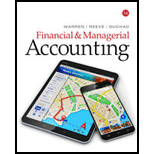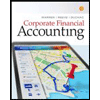
Concept explainers
(a)
Stock Dividends: It refers to the payment of the dividend to its shareholders by the corporation in the form of shares rather than cash is referred as stock dividend.
To
(a)
Answer to Problem 12.10EX
Record the declaration and issuance of stock dividends.
| Transaction Number | Account Titles and Explanation | Debit ($) | Credit ($) |
| 1 | Stock Dividends (2) | 1,980,000 | |
Common Stock Dividends (3) |
1,650,000 | ||
Paid-in Capital in excess of Par Value-Common stock (4) |
330,000 | ||
| (To record the declaration of stock dividends) | |||
| 2 | Stock Dividends Distributable (3) | 1,650,000 | |
| Common Stock | 1,650,000 | ||
| (To record the distribution of stock dividends) | |||
Table (1)
Compute the number of stock dividends shares declared.
Compute the stock dividends amount payable to common stockholders.
Compute stock dividends distributable value.
Compute paid-in capital in excess of par value-common stock.
Explanation of Solution
Transaction 1: Declared 5% of stock dividends.
- Stock Dividends is a contra-stockholders’ equity account which decreases the stockholders’ equity amount. Therefore, debit Stock Dividends account with $1,980,000.
- Common Stock Dividends Distributable is a stockholders’ equity account and the amount has increased due to the declaration of stock dividends. Therefore, credit Common Stock Dividends Distributable account with $1,650,000.
- Paid-in Capital in Excess of Par Value is a stockholders’ equity account and the amount has increased due to increase in capital excess of common stock value. Therefore, credit Paid-in Capital in Excess of Par Value account with $330,000.
Transaction 2: Distribution of stock dividends declared.
- Common Stock Dividends Distributable is a stockholders’ equity account and the amount has decreased due to transfer of Common Stock Dividends Distributable amount to Common Stock account. Therefore, debit Common Stock Dividends Distributable account with $1,650,000.
- Common Stock is stockholders’ equity account and the amount has increased. Therefore, credit Common Stock account with $1,650,000.
(b)
(1) Total paid-in capital, (2) total retained earnings, and (3) total stockholders’ equity amount before the declaration of the stock dividends.
(b)
Explanation of Solution
(1)
Determine total paid-in capital amount before the declaration of the stock dividends.
Hence, the total paid-in capital amount before the declaration of the stock dividends is $42,000,000.
(2)
Determine total retained earnings amount before the declaration of the stock dividends.
It is given that HL Company’s retained earnings before the declaration of the stock dividends is $89,550,000.
Hence, the total retained earnings amount before the declaration of the stock dividends is $89,550,000.
(3)
Determine total stockholders’ equity amount before the declaration of the stock dividends.
Hence, the total stockholders’ equityamount before the declaration of the stock dividends is $131,550,000.
(c)
(1) Total paid-in capital, (2) total retained earnings, and (3) total stockholders’ equity amount after the declaration of the stock dividends.
(c)
Explanation of Solution
(1)
Determine total paid-in capital amount after the declaration of the stock dividends.
Hence, the total paid-in capital amount after the declaration of the stock dividends is $43,980,000.
(2)
Determine total retained earnings amount after the declaration of the stock dividends.
Hence, the total retained earnings amount after the declaration of the stock dividends is $87,570,000.
(3)
Determine total stockholders’ equity amount after the declaration of the stock dividends.
Hence, the total stockholders’ equityamount after the declaration of the stock dividends is $131,550,000.
Want to see more full solutions like this?
Chapter 12 Solutions
Financial and Managerial Accounting - With CengageNow
- I need help finding the accurate solution to this general accounting problem with valid methods.arrow_forwardI am looking for the correct answer to this general accounting problem using valid accounting standards.arrow_forwardJimmy Entertainment Corporation was organized on March 1, 2018. During 2020, Jimmy Entertainment issued 30,000 shares at $12 per share, purchased 3,500 shares of treasury stock at $14 per share, and had a net income of $210,000. What is the total amount of stockholders' equity at December 31, 2020?arrow_forward
- Could you help me solve this financial accounting question using appropriate calculation techniques?arrow_forwardYosemite Industries reported FIFO ending inventory of $143,700 and a beginning inventory of $138,500 for 2022. Inventory purchases for 2022 were $312,800, and the change in the LIFO reserve for 2021 was an increase in the LIFO reserve of $1,250. Calculate the value of COGS LIFO for Yosemite Industries in 2022.arrow_forwardPlease help me solve this general accounting question using the right accounting principles.arrow_forward
- Dorset Manufacturing produces a single product that sells for $125 per unit. Variable costs are $72 per unit, and fixed costs total $186,000 per month. Calculate the operating income if the selling price is raised to $132 per unit, marketing expenditures are increased by $24,000 per month, and monthly unit sales volume becomes 4,800 units.arrow_forwardI need help with this financial accounting question using standard accounting techniques.arrow_forwardI am trying to find the accurate solution to this general accounting problem with the correct explanation.arrow_forward
- 9. The gross profit margin is 40%, and sales are $50,000. What is the cost of goods sold?A. $20,000B. $30,000C. $40,000D. $50,000arrow_forwardParker sells a parcel of land for $92,000 cash, and the buyer assumes Parker's liability of $13,500 on the land. Parker's basis in the land is $78,000. What is the gain or loss he will recognize on the sale? A. $14,000 gain B. $27,500 gain C. $27,500 loss D. $14,000 lossarrow_forwardI need assistance with this financial accounting question using appropriate principles.arrow_forward
 Financial AccountingAccountingISBN:9781305088436Author:Carl Warren, Jim Reeve, Jonathan DuchacPublisher:Cengage Learning
Financial AccountingAccountingISBN:9781305088436Author:Carl Warren, Jim Reeve, Jonathan DuchacPublisher:Cengage Learning Cornerstones of Financial AccountingAccountingISBN:9781337690881Author:Jay Rich, Jeff JonesPublisher:Cengage Learning
Cornerstones of Financial AccountingAccountingISBN:9781337690881Author:Jay Rich, Jeff JonesPublisher:Cengage Learning Managerial Accounting: The Cornerstone of Busines...AccountingISBN:9781337115773Author:Maryanne M. Mowen, Don R. Hansen, Dan L. HeitgerPublisher:Cengage Learning
Managerial Accounting: The Cornerstone of Busines...AccountingISBN:9781337115773Author:Maryanne M. Mowen, Don R. Hansen, Dan L. HeitgerPublisher:Cengage Learning Financial And Managerial AccountingAccountingISBN:9781337902663Author:WARREN, Carl S.Publisher:Cengage Learning,
Financial And Managerial AccountingAccountingISBN:9781337902663Author:WARREN, Carl S.Publisher:Cengage Learning, Financial AccountingAccountingISBN:9781337272124Author:Carl Warren, James M. Reeve, Jonathan DuchacPublisher:Cengage Learning
Financial AccountingAccountingISBN:9781337272124Author:Carl Warren, James M. Reeve, Jonathan DuchacPublisher:Cengage Learning Corporate Financial AccountingAccountingISBN:9781305653535Author:Carl Warren, James M. Reeve, Jonathan DuchacPublisher:Cengage Learning
Corporate Financial AccountingAccountingISBN:9781305653535Author:Carl Warren, James M. Reeve, Jonathan DuchacPublisher:Cengage Learning





